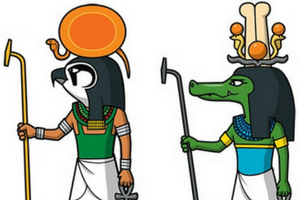Welcome to Facts Vibes! Uncover the mystique of Anubis, the enigmatic Egyptian god of mummification and the afterlife. Explore intriguing facts and lesser-known aspects of this iconic deity in our article. Delve into the folklore and symbolism surrounding Anubis as we unravel the secrets of ancient Egyptian mythology.
Anubis: Unraveling the Enigmatic Egyptian Deity
Anubis, often depicted as a jackal-headed figure, is an enigmatic deity in ancient Egyptian religion and mythology. He played a crucial role in the afterlife, being responsible for guiding souls to the underworld and presiding over mummification and funerary rites. The significance of Anubis in Egyptian society is evident from the extensive references to him in religious texts and the widespread use of his images in tombs and temples.
One of the most intriguing aspects of Anubis is his complex nature, as he embodies both the divine and the mortal. His role as a guardian of the dead highlights the powerful symbolism associated with death and rebirth in ancient Egyptian beliefs. In art and literature, Anubis is often portrayed as a solemn and mysterious figure, representing the mysteries of the afterlife and the rituals surrounding death.
The mythological narratives involving Anubis reveal his significance in the Egyptian pantheon. He is often linked with the god Osiris, playing a crucial role in the preservation and rebirth of Osiris after his murder by Set. This association underscores Anubis’ role as a key figure in the cycle of life, death, and renewal in Egyptian cosmology.
Furthermore, the symbolism of Anubis extends beyond his specific religious functions to encompass broader themes of transition and transformation. As a guide to the underworld, he represents the journey from one state of existence to another, embodying the concept of transition between life and death.
In modern times, Anubis continues to fascinate scholars and enthusiasts alike, inspiring ongoing research and artistic interpretations. The symbolism and metaphysical connotations associated with Anubis make him a compelling subject for exploration in the context of ancient Egyptian religion and mythology.
Through unraveling the enigmatic nature of Anubis, we gain deeper insights into the complexities of ancient Egyptian belief systems and the enduring legacy of their religious traditions.
Most popular facts
Anubis is the ancient Egyptian god of mummification and the afterlife.
Anubis is the ancient Egyptian god of mummification and the afterlife.
He is often depicted with the head of a jackal and the body of a human.
He is often depicted with the head of a jackal and the body of a human.
Anubis played a crucial role in the mummification process, overseeing the weighing of the heart against the feather of Ma’at.
Anubis played a crucial role in the mummification process, overseeing the weighing of the heart against the feather of Ma’at.
His role also extended to protection and guidance in the journey through the underworld.
His role extended to protection and guidance in the journey through the underworld.
Anubis was considered one of the most important and revered deities in ancient Egyptian mythology.
Anubis was considered one of the most important and revered deities in ancient Egyptian mythology.
The black color associated with Anubis represented fertility, life, and the regeneration of the Nile’s fertile soil.
The black color associated with Anubis represented fertility, life, and the regeneration of the Nile’s fertile soil.
Worship of Anubis dates back to the early dynastic period in Egypt (c. 3100-2686 BCE).
The worship of Anubis dates back to the early dynastic period in Egypt (c. 3100-2686 BCE).
He was closely associated with cemeteries and tombs, as well as rituals related to death and burial practices.
He was closely associated with cemeteries and tombs, as well as rituals related to death and burial practices.
Anubis was believed to be the son of the goddess Nephthys and either Set or Osiris.
Anubis was believed to be the son of the goddess Nephthys and either Set or Osiris.
He played a significant role in the mythology surrounding the judgment of the deceased in the afterlife.
Anubis played a significant role in the mythology surrounding the judgment of the deceased in the afterlife.
Anubis was often invoked for protection and guidance during funeral rites and burial ceremonies.
Anubis was often invoked for protection and guidance during funeral rites and burial ceremonies.
Many ancient Egyptian tombs and funerary texts included prayers and invocations to Anubis.
Ancient Egyptian tombs and funerary texts often included prayers and invocations to Anubis.
He was also linked to the safe passage of souls to the afterlife and the protection of their mortal remains.
Anubis was linked to the safe passage of souls to the afterlife and the protection of their mortal remains.
Anubis was associated with the constellation known as “Jackal’s Glimpse,” which was also tied to the flooding of the Nile.
Anubis was associated with the constellation known as “Jackal’s Glimpse,” which was also tied to the flooding of the Nile.
Over time, Anubis became assimilated with other funerary deities, such as Osiris, and continued to maintain his significance in Egyptian religious beliefs.
Anubis became assimilated with other funerary deities, such as Osiris, and continued to maintain his significance in Egyptian religious beliefs over time.
In conclusion, Anubis, the Egyptian god of mummification and the afterlife, holds a significant place in ancient Egyptian mythology. His role as the protector of the dead and guide through the underworld provides a fascinating insight into the beliefs and rituals of ancient Egypt. Exploring the myths and facts surrounding Anubis offers a deeper understanding of the cultural and religious practices of this ancient civilization.
